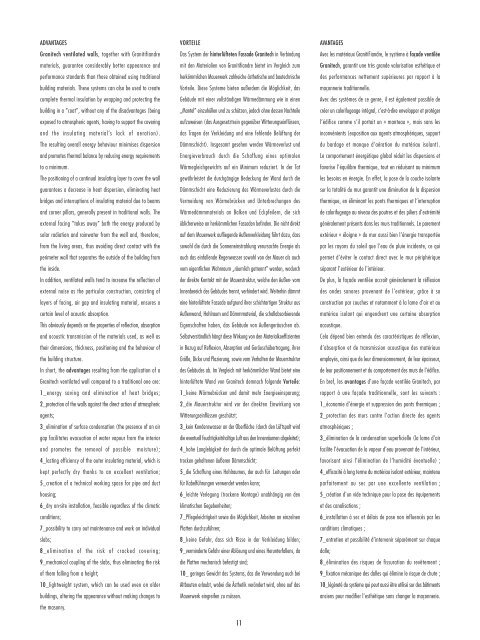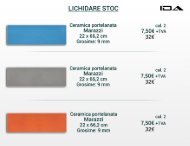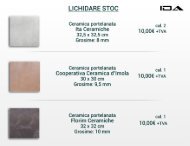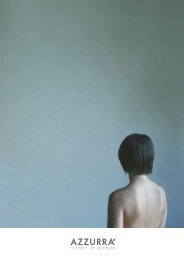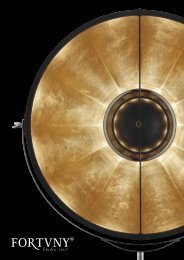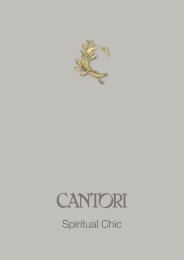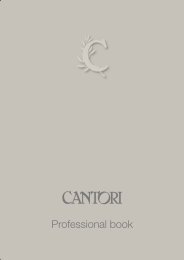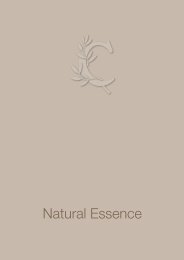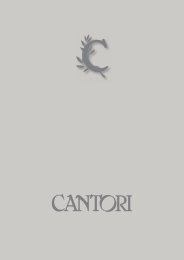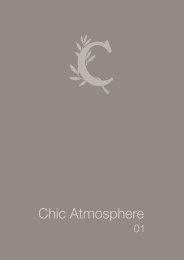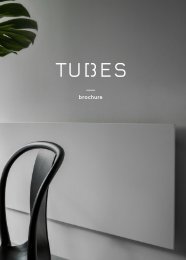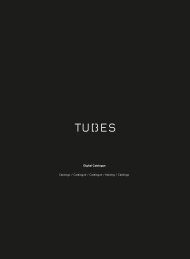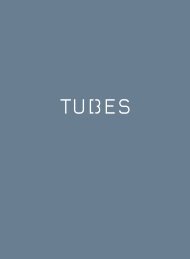Graniti Fiandre - Manualul Inginerului
You also want an ePaper? Increase the reach of your titles
YUMPU automatically turns print PDFs into web optimized ePapers that Google loves.
ADVANTAGES<br />
Granitech ventilated walls, together with <strong>Graniti</strong>fiandre<br />
materials, guarantee considerably better appearance and<br />
performance standards than those obtained using traditional<br />
building materials. These systems can also be used to create<br />
complete thermal insulation by wrapping and protecting the<br />
building in a “coat”, without any of the disadvantages (being<br />
exposed to atmospheric agents, having to support the covering<br />
and the insulating material’s lack of aeration).<br />
The resulting overall energy behaviour minimises dispersion<br />
and promotes thermal balance by reducing energy requirements<br />
to a minimum.<br />
The positioning of a continual insulating layer to cover the wall<br />
guarantees a decrease in heat dispersion, eliminating heat<br />
bridges and interruptions of insulating material due to beams<br />
and corner pillars, generally present in traditional walls. The<br />
external facing “takes away” both the energy produced by<br />
solar radiation and rainwater from the wall and, therefore,<br />
from the living areas, thus avoiding direct contact with the<br />
perimeter wall that separates the outside of the building from<br />
the inside.<br />
In addition, ventilated walls tend to increase the reflection of<br />
external noise as the particular construction, consisting of<br />
layers of facing, air gap and insulating material, ensures a<br />
certain level of acoustic absorption.<br />
This obviously depends on the properties of reflection, absorption<br />
and acoustic transmission of the materials used, as well as<br />
their dimensions, thickness, positioning and the behaviour of<br />
the building structure.<br />
In short, the advantages resulting from the application of a<br />
Granitech ventilated wall compared to a traditional one are:<br />
1_energy saving and elimination of heat bridges;<br />
2_protection of the walls against the direct action of atmospheric<br />
agents;<br />
3_elimination of surface condensation (the presence of an air<br />
gap facilitates evacuation of water vapour from the interior<br />
and promotes the removal of possible moisture);<br />
4_lasting efficiency of the outer insulating material, which is<br />
kept perfectly dry thanks to an excellent ventilation;<br />
5_creation of a technical working space for pipe and duct<br />
housing;<br />
6_dry on-site installation, feasible regardless of the climatic<br />
conditions;<br />
7_possibility to carry out maintenance and work on individual<br />
slabs;<br />
8_elimination of the risk of cracked covering;<br />
9_mechanical coupling of the slabs, thus eliminating the risk<br />
of them falling from a height;<br />
10_lightweight system, which can be used even on older<br />
buildings, altering the appearance without making changes to<br />
the masonry.<br />
VORTEILE<br />
Das System der hinterlüfteten Fassade Granitech in Verbindung<br />
mit den Materialien von <strong>Graniti</strong>fiandre bietet im Vergleich zum<br />
herkömmlichen Mauerwerk zahlreiche ästhetische und bautechnische<br />
Vorteile. Diese Systeme bieten außerdem die Möglichkeit, das<br />
Gebäude mit einer vollständigen Wärmedämmung wie in einen<br />
„Mantel“ einzuhüllen und zu schützen, jedoch ohne dessen Nachteile<br />
aufzuweisen (das Ausgesetztsein gegenüber Witterungseinflüssen,<br />
das Tragen der Verkleidung und eine fehlende Belüftung der<br />
Dämmschicht). Insgesamt gesehen werden Wärmeverlust und<br />
Energieverbrauch durch die Schaffung eines optimalen<br />
Wärmegleichgewichts auf ein Minimum reduziert. In der Tat<br />
gewährleistet die durchgängige Bedeckung der Wand durch die<br />
Dämmschicht eine Reduzierung des Wärmeverlustes durch die<br />
Vermeidung von Wärmebrücken und Unterbrechungen des<br />
Wärmedämmmaterials an Balken und Eckpfeilern, die sich<br />
üblicherweise an herkömmlichen Fassaden befinden. Die nicht direkt<br />
auf dem Mauerwerk aufliegende Außenverkleidung führt dazu, dass<br />
sowohl die durch die Sonneneinstrahlung verursachte Energie als<br />
auch das einfallende Regenwasser sowohl von der Mauer als auch<br />
vom eigentlichen Wohnraum „räumlich getrennt” werden, wodurch<br />
der direkte Kontakt mit der Mauerstruktur, welche den Außen- vom<br />
Innenbereich des Gebäudes trennt, verhindert wird. Weiterhin dämmt<br />
eine hinterlüftete Fassade aufgrund ihrer schichtartigen Struktur aus<br />
Außenwand, Hohlraum und Dämmmaterial, die schallabsorbierende<br />
Eigenschaften haben, das Gebäude von Außengeräuschen ab.<br />
Selbstverständlich hängt diese Wirkung von den Materialkoeffizienten<br />
in Bezug auf Reflexion, Absorption und Geräuschübertragung, ihrer<br />
Größe, Dicke und Plazierung, sowie vom Verhalten der Mauerstruktur<br />
des Gebäudes ab. Im Vergleich mit herkömmlicher Wand bietet eine<br />
hinterlüftete Wand von Granitech demnach folgende Vorteile:<br />
1_keine Wärmebrücken und damit mehr Energieeinsparung;<br />
2_die Mauerstruktur wird vor der direkten Einwirkung von<br />
Witterungseinflüssen geschützt;<br />
3_kein Kondenswasser an der Oberfläche (durch den Lüftspalt wird<br />
die eventuell feuchtigkeitshaltige Luft aus den Innenräumen abgeleitet);<br />
4_hohe Langlebigkeit der durch die optimale Belüftung perfekt<br />
trocken gehaltenen äußeren Dämmschicht;<br />
5_die Schaffung eines Hohlraumes, der auch für Leitungen oder<br />
für Kabelführungen verwendet werden kann;<br />
6_leichte Verlegung (trockene Montage) unabhängig von den<br />
klimatischen Gegebenheiten;<br />
7_Pflegeleichtigkeit sowie die Möglichkeit, Arbeiten an einzelnen<br />
Platten durchzuführen;<br />
8_keine Gefahr, dass sich Risse in der Verkleidung bilden;<br />
9_verminderte Gefahr einer Ablösung und eines Herunterfallens, da<br />
die Platten mechanisch befestigt sind;<br />
10_ geringes Gewicht des Systems, das die Verwendung auch bei<br />
Altbauten erlaubt, wobei die Ästhetik verändert wird, ohne auf das<br />
Mauerwerk eingreifen zu müssen.<br />
11<br />
AVANTAGES<br />
Avec les matériaux <strong>Graniti</strong><strong>Fiandre</strong>, le système à façade ventilée<br />
Granitech, garantit une très grande valorisation esthétique et<br />
des performances nettement supérieures par rapport à la<br />
maçonnerie traditionnelle.<br />
Avec des systèmes de ce genre, il est également possible de<br />
créer un calorifugeage intégral, c’est-à-dire envelopper et protéger<br />
l’édifice comme s’il portait un « manteau », mais sans les<br />
inconvénients (exposition aux agents atmosphériques, support<br />
du bardage et manque d’aération du matériau isolant).<br />
Le comportement énergétique global réduit les dispersions et<br />
favorise l’équilibre thermique, tout en réduisant au minimum<br />
les besoins en énergie. En effet, la pose de la couche isolante<br />
sur la totalité du mur garantit une diminution de la dispersion<br />
thermique, en éliminant les ponts thermiques et l’interruption<br />
de calorifugeage au niveau des poutres et des piliers d’extrémité<br />
généralement présents dans les murs traditionnels. Le parement<br />
extérieur « éloigne » du mur aussi bien l'énergie transportée<br />
par les rayons du soleil que l'eau de pluie incidente, ce qui<br />
permet d'éviter le contact direct avec le mur périphérique<br />
séparant l'extérieur de l'intérieur.<br />
De plus, la façade ventilée accroît généralement la réflexion<br />
des ondes sonores provenant de l'extérieur, grâce à sa<br />
construction par couches et notamment à la lame d’air et au<br />
matériau isolant qui engendrent une certaine absorption<br />
acoustique.<br />
Cela dépend bien entendu des caractéristiques de réflexion,<br />
d’absorption et de transmission acoustique des matériaux<br />
employés, ainsi que de leur dimensionnement, de leur épaisseur,<br />
de leur positionnement et du comportement des murs de l’édifice.<br />
En bref, les avantages d'une façade ventilée Granitech, par<br />
rapport à une façade traditionnelle, sont les suivants :<br />
1_économie d’énergie et suppression des ponts thermiques ;<br />
2_protection des murs contre l’action directe des agents<br />
atmosphériques ;<br />
3_élimination de la condensation superficielle (la lame d’air<br />
facilite l’évacuation de la vapeur d’eau provenant de l’intérieur,<br />
favorisant ainsi l’élimination de l’humidité éventuelle) ;<br />
4_efficacité à long terme du matériau isolant extérieur, maintenu<br />
parfaitement au sec par une excellente ventilation ;<br />
5_création d'un vide technique pour la pose des équipements<br />
et des canalisations ;<br />
6_installation à sec et délais de pose non influencés par les<br />
conditions climatiques ;<br />
7_entretien et possibilité d’intervenir séparément sur chaque<br />
dalle;<br />
8_élimination des risques de fissuration du revêtement ;<br />
9_fixation mécanique des dalles qui élimine le risque de chute ;<br />
10_légèreté du système qui peut aussi être utilisé sur des bâtiments<br />
anciens pour modifier l’esthétique sans changer la maçonnerie.


